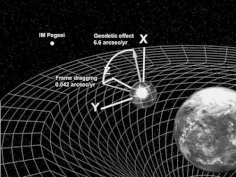
Back تأثير جيوديسي Arabic Efecte geodèsic Catalan Geodetický efekt Czech Geodätischer Effekt German Efecto geodésico Spanish اثر ژئودزیکی Persian Précession géodétique French Գեոդեզիկ էֆեկտ Armenian Effetto geodetico Italian Efeito geodético Portuguese

The geodetic effect (also known as geodetic precession, de Sitter precession or de Sitter effect) represents the effect of the curvature of spacetime, predicted by general relativity, on a vector carried along with an orbiting body. For example, the vector could be the angular momentum of a gyroscope orbiting the Earth, as carried out by the Gravity Probe B experiment. The geodetic effect was first predicted by Willem de Sitter in 1916, who provided relativistic corrections to the Earth–Moon system's motion. De Sitter's work was extended in 1918 by Jan Schouten and in 1920 by Adriaan Fokker.[1] It can also be applied to a particular secular precession of astronomical orbits, equivalent to the rotation of the Laplace–Runge–Lenz vector.[2]
The term geodetic effect has two slightly different meanings as the moving body may be spinning or non-spinning. Non-spinning bodies move in geodesics, whereas spinning bodies move in slightly different orbits.
The difference between de Sitter precession and Lense–Thirring precession (frame dragging) is that the de Sitter effect is due simply to the presence of a central mass, whereas Lense–Thirring precession is due to the rotation of the central mass. The total precession is calculated by combining the de Sitter precession with the Lense–Thirring precession.
- ^ Jean Eisenstaedt; Anne J. Kox (1988). Studies in the History of General Relativity. Birkhäuser. p. 42. ISBN 0-8176-3479-7.
- ^ de Sitter, W (1916). "On Einstein's Theory of Gravitation and its Astronomical Consequences". Mon. Not. R. Astron. Soc. 77: 155–184. Bibcode:1916MNRAS..77..155D. doi:10.1093/mnras/77.2.155.